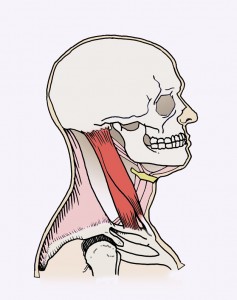I often see clients with neck and shoulder pain exhibiting a classic imbalance between the muscles at the front and the back of the neck: the sternocleidomastoid muscle (SCM) – responsible for tilting and rotating the head – the mastoid (a big rope that connects your head, rib cage and shoulder girdle), and the trapezius. The trapezius is a big, strong diamond shaped muscle on our back that stabilizes the shoulder blades on the back; it connects at the base of the head, on either shoulder and the top of the spine. All movements of the shoulders blade involve the trapezius in some way or another and it has some minor involvement with tilting and turning of the head.
Forward head posture throws the relationship of these muscles into disarray. When the head moves forward the spine goes with it. This pulls the shoulder blades forward as well, not only do they make contact with the upper ribcage, but they begin to pull the ribcage forward as well.
The SCM that should be involved in turning and nodding your head, instead is called upon to hold the head up in space. As a result the trapezius becomes largely responsible for turning and nodding the head.
Try to feel the difference of the two actions in your muscles.
- Let the head fall even more forward than usual and turn and nod the head.
- See if you feel that the muscular sensation of turning is generated from the back of the neck.
- Now pull the sides of the neck back, lengthen the ears back and up. What happens when you turn and nod your head here?
Ideally the focus of the effort changes from the back of the neck to the front of the throat where it should come from.
Forward head posture throws off a number of key relationships in the body and for us the main culprit for forward head posture is a tucked pelvis and poor abdominal tone.
An awareness of this – and postural correction – is important for people suffering from neck and shoulder pain. As well as myofascial release, soft tissue release and trigger point therapy I also integrate sports stretching to my massage therapy work to release tension in these muscles, freeing the movement and allowing the head, neck and shoulders to move without restriction.

